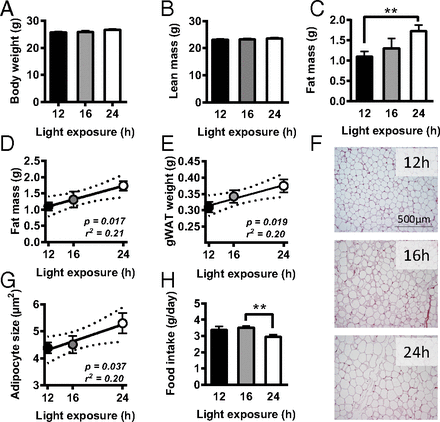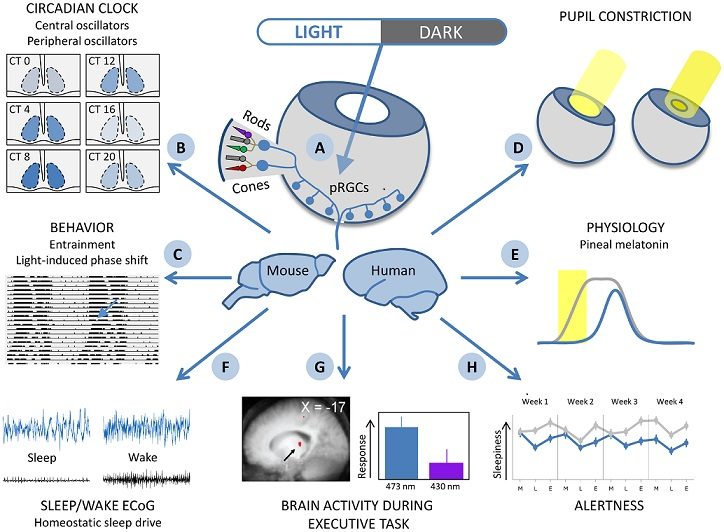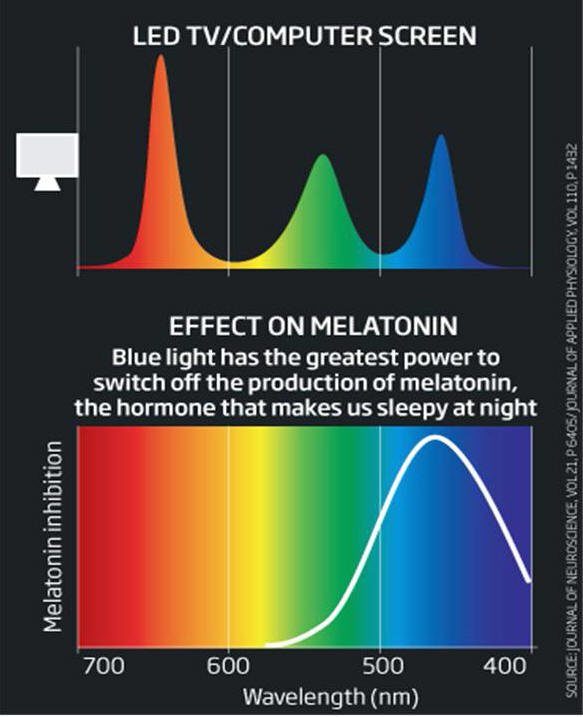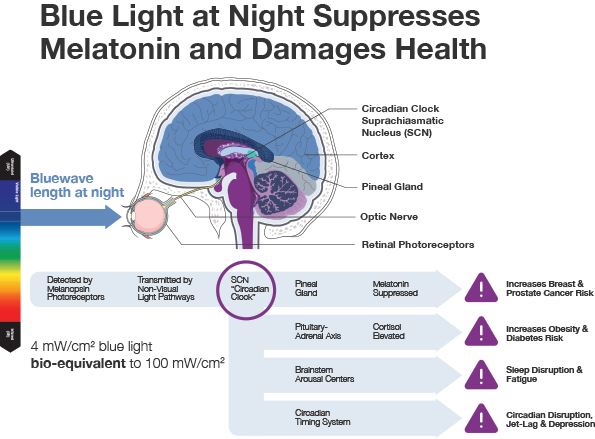A recent study published by Penn State College of Medicine is the latest to shine light (no pun intended) on the detrimental effects that exposure to artificial light at night-time can have on the human body. Science Daily reports:
After surveying parents about their kids' technology and sleep habits, researchers found that using technology before bed was associated with less sleep, poorer sleep quality, more fatigue in the morning and -- in the children that watched TV or used their cell phones before bed -- higher body mass indexes (BMI).The study found that children who spent more time looking at electronic screens (of various devices) at night were more likely to be obese/severely obese. OK, so this was a survey-based study and the conclusions were drawn from associations. Here one could argue that correlation does not imply causation. But when these results are placed in a much wider context and taken together with the wealth of other data available on this topic, it begins to paint a very disturbing picture.
"We saw technology before bed being associated with less sleep and higher BMIs," Fuller said. "We also saw this technology use being associated with more fatigue in the morning, which circling back, is another risk factor for higher BMIs. So we're seeing a loop pattern forming."
First of all, despite the fact that they are almost twice as sensitive to artificial light at night time than us adults, this does not only apply to children.
Take a look at some other recent research:
This study is the first population-level study that confirms the results of laboratory research and cohort studies in which ALAN [artificial light at night] was found to be a contributing factor to excessive body mass in humans.
The findings of our study provide epidemiological evidence that outdoor ALAN is significantly related to obesity.
In this analysis of over 113,000 United Kingdom women, BMI [Body Mass Index], WHR [Waist to Hip Ratio], WHtR [Waist to Height Ratio], and waist circumference increased with increasing lightness of the room slept in at night.So there is a clear association between light exposure in the evening and weight gain. The same associations have been found in most of the rodent studies also. In fact, in one study, titled 'Prolonged daily light exposure increases body fat mass through attenuation of brown adipose tissue activity', researchers have shown that you can make mice FAT simply by adding just 4 hours of extra daylight to their schedule.
In conclusion, we found evidence of a significant association between LAN [light at night] exposure and obesity in humans that was not explained by potential confounders we could measure.
Bill Lagakos has covered this extensively on his blog in the past, along with Dr Jack Kruse, but the message is well worth repeating:
This research found that by manipulating day-length with artificial light, they could significantly increase body fat mass in mice within five weeks! This finding was independent of food intake and physical activity levels. If you take a look at the graph below, you will see that the mice that stored the most fat (24hr light exposure) actually ate LESS than the ones who stored the least (12hr light exposure).

The authors state:
We report that prolonging daily light exposure increases adiposity by decreasing energy expenditure rather than increasing food intake or locomotor activity. This was caused by a light-exposure period-dependent attenuation of the noradrenergic activation of brown adipose tissue that has recently been shown to contribute substantially to energy expenditure by converting fatty acids and glucose into heat. Therefore, we conclude that impaired brown adipose tissue activity may mediate the relationship between increased light exposure and adiposity.These findings suggest that the circadian rhythm trumps calorie-counting and exercise for weight loss. If you want to lose fat, it might be a good idea to start focusing on getting a good night's sleep.
[..]
In conclusion, our study provides evidence that prolonged daily light exposure increases body fat mass through reduction of BAT activity. The present findings support the hypothesis that the relationship between disturbed circadian rhythmicity and adiposity in humans is mediated by impaired BAT activity.
Lagakos cites another study which showed similar results in humans:
Sleep curtailment decreased the proportion of weight lost as fat by 55% (1.4 vs. 0.6 kg with 8.5 vs. 5.5 hours of sleep opportunity, respectively; P = 0.043) and increased the loss of fat-free body mass by 60% (1.5 vs. 2.4 kg; P = 0.002).The people who got 8.5 hours sleep lost significantly more fat, whereas the people who got 5.5 hours sleep lost much less fat and significantly more muscle. Note that the people in this study consumed exactly the same amount of calories in their diets. This brings home the point that weight/fat loss is not necessarily determined just by what you eat. Rather, it appears to be governed by how the body processes that food - which in inextricably tied to the circadian rhythm.
How might this happen? Think Leptin!
Leptin is one of the hormones (primarily produced by fat cells) responsible for regulating satiety, energy storage, and energy expenditure (amongst many other functions). It serves the role of communicating information to the brain about how much energy is available in the environment (and on your hips).
For example, after you consume a meal, fat cells will respond by releasing leptin in sufficient quantities, which then travels in circulation to the brain. There, it binds with the hypothalamus (a control center) to send a signal which basically says, "Hey brain, I have just eaten a large meal and have enough energy/fat to survive for a while. We don't need to eat anymore food!" So in response to this information, the hypothalamus initiates a cascade of events which ultimately functions to: 1.) make you feel full (to stop you from eating any more than necessary and becoming fat), and 2.) increase energy expenditure.
In contrast, when the hypothalamus detects low levels of leptin, it perceives this as a lack of stored energy/fat - because fat cells are usually what produce the most leptin. As an adaptive response to this perceived low-energy state, the hypothalamus will initiate a different cascade of events to: 1.) make you feel hungry (so that you can increase your fat stores), and 2.) decrease total energy expenditure because, after all, when you are starving to death you don't want to run through all of your energy stores too quickly. What normally happens in this state is that a person eats a meal and the cycle starts over again.
What's the problem in obesity? It seems to be related to a condition called leptin resistance, a state whereby leptin can no longer "bind" effectively with the hypothalamus to communicate information that food/energy/fat is abundant. It is difficult to measure in humans, but researchers have proposed that it may be a potential underlying factor in obesity.
For the obese person it might play out like this: after a meal, large amounts of leptin are released into circulation from fat cells. Leptin travels to the brain, but is unable to bind. Therefore, the hypothalamus perceives that the body is starving, even though it is not. So despite there being adequate amounts of energy, the hypothalamus will ramp up feelings of hunger, causing the person to eat more, and ramp down energy expenditure, causing the person to burn less. Multiply this by a year or two, and you can imagine how it can rapidly spiral downward into a state of morbid obesity.
How does this relate to artificial light and circadian rhythms? Well, several factors have been implicated as possible causes for leptin resistance, including oxidative stress. However, according to the author of one paper:
Recent research has shown that circadian disruption can abolish the normal diurnal variation in serum leptin, independently of changes in external food cues or physical activity. However, the underlying mechanism for this phenomenon and how it leads to weight gain were unknown. Now, Kettner et al. show that the peripheral circadian clock directly regulates leptin transcription in adipose tissue, and that the central circadian clock plays a dominant role in response to leptin signaling. Furthermore, the authors show that circadian disruption induces leptin resistance independent of other risk factors for obesity.In short, leptin follows a 24-hour circadian rhythm which is controlled by "CLOCK" genes. In experimental settings "circadian disruption" in and of itself can destroy this rhythm, reduce the hypothalamus' sensitivity to the leptin signal, thereby inducing leptin resistance and obesity.
For those who want the details, read the following from the study itself:
Based on our findings, we conclude that the circadian homeostasis of Leptin-mediated neuroendocrine feedback loop is a key mechanism for the clock to control long-term energy balance at the organismal level. In the adipose, BMAL1/CLOCK directly controls circadian leptin transcription that drives the rhythm of serum Leptin. In the CNS, the SCN clock potentiates the response of LEPR-B expressing ARC neurons to circulating Leptin to maintain the balance of food-intake and energy expenditure. Under normal physiological conditions, the activities of central and peripheral clock are coupled with environmental cues. Acute circadian disruption abolishes peripheral clock-controlled leptin expression in adipose to suppress plasma Leptin levels, leading to a shift in energy balance and weight gain. Increased fat mass elevates circulating Leptin. However, chronic circadian dysfunction desensitizes the LEPR-B expressing ARC neurons to increased Leptin signaling, resulting in Leptin resistance, a hallmark of obesity in humans.So let's examine what might constitute "circadian disruption". In the above study, the researchers subjected mice to "chronic jet lag conditions" which were frankly abnormal and would probably never occur for the majority of people.
However, it seems as though circadian disruption can be induced simply by exposing yourself to bright light in the evenings.
Exposure to light at night perturbs the circadian system because light is the major entraining cue used by the body to discriminate day and night. When exposure to light is mistimed or nearly constant, biological and behavioral rhythms can become desynchronized, leading to negative consequences for health. Mood disorders have long been associated with light and circadian rhythms. One example is seasonal affective disorder in which mood oscillates between dysthymia during the short day lengths of winter and euthymia during the long summer days. In fact, a striking number of mood disorders are either characterized by sleep and circadian rhythm disruption or precipitated by an irregular light cycle.The role of melatonin
Melatonin is classically referred to as the "sleep hormone" or the "hormone of darkness". It is synthesised within the brain in the pineal gland and is released in rhythm fashion. The daily secretion of melatonin is regulated by the brain's "master clock", the suprachiasmatic nucleus, and is responsive to environmental light/dark cycles. Melatonin plays a major role in regulating the light-sensitive biological clocks involved in coordinating the activity of ordinary physiological processes.
Just so you get a clearer picture, here are some of melatonin's attributes:
- Promotes restful sleep, tiredness, and is involved in entraining the circadian rhythm.
- Regulates metabolic rate and thermogenesis
- A powerful antioxidant both in the brain and the periphery: responsible for mopping up free radicals and mitigating oxidative damage. Has been shown to upregulate cellular antioxidant systems including superoxide dismutase, glutathione peroxidase, and γ-glutamylcysteine synthase
- Protective to the cell's mitochondria: neutralises mitochondrial toxins and reactive oxygen species.
- Anti-inflammatory: capable of regulating immune function and reducing markers of inflammation including IL-1B, IL-6, IL-8, TNF-a
Now back to the topic of circadian disruption. It seems as though a fairly accurate way of assessing the degree of 'dysfunctionality' of the circadian rhythm is by measuring melatonin levels. This is because people with a poor circadian rhythm also seem to have lower night-time melatonin levels and/or altered times of melatonin onset. Ideally, we should all hope to be producing enough melatonin each night to get an adequate quality of sleep. Unfortunately, this has become a difficult task for many people in the modern world.
What can stop the brain from secreting melatonin? Blue light exposure through the eyes
The retina of the eye contains specialised cells called "intrinsically photosensitive retinal ganglion cells" (ipRGCs) which perform non image-related functions, such as phototransduction. These ipRGC cells express melanopsin, a photopigment that is highly sensitive to blue light (~480nm), and are significantly less sensitive to red light (~600nm). When this pigment is exposed to blue light, it activates the ipRGCs and triggers a signal which is sent directly to the suprachiasmatic nucleus (the master clock) via the retinohypothalamic pathway. Recall that it is the master clock's job to regulate melatonin synthesis and release. In the absence of blue light, melatonin production starts. Whereas in the presence of blue light, melatonin synthesis grinds to a halt.
Blue light is present in high amounts in daytime sunlight, whereas it decreases significantly at sunset. Why is this significant? Well, the human eye is designed to sense environmental light fluctuations via these photopigments so that it can convey this information to the brain. The brain can respond by appropriately altering physiological functions in order to suit the requirements for time of day.
In straight-forward terms:
- Melatonin makes us feel sleepy and promotes rest. Melatonin production is suppressed by blue light in the daytime, because daytime sunlight contains a lot of blue light. This is good, because most of us don't want to feel sleepy in the daytime, and instead we feel alert.
- At sunset, environmental blue light levels drop as it begins to get dark. The lack of blue light acts as a trigger for melatonin synthesis to begin.
- We begin to feel sleepy after sunset and go to sleep.
- As the sun begins to rise again, melatonin levels start to drop. We wake up to a big dose of blue light in our eyes, we feel alert, and BOOM the cycle starts again. This is how things should work.
Blue light exposure at night time "tricks" the brain because it acts as a signal to communicate that it is daytime, even when its night time. So instead of preparing for the regenerative physiological activities that should ideally take place during sleep, the brain is forced into directing various body systems to prepare for daytime activities instead. With this considered, is it any wonder why cases of insomnia are through the roof?
One study found that exposure to ordinary room light before bed not only strongly inhibited the onset of melatonin production, but also shortened the duration of melatonin secretion by approximately 90 minutes. Furthermore, exposure to light during the usual hours of sleep suppressed melatonin by more than 50%! In addition to this, there have been numerous studies in the past which have provided similar results.
However, it is important to note here that melatonin is merely one player in an infinitely complex circadian system.

Physiological function at the cellular, tissue, organ, and organism level are all influenced by the rhythms generated by these circadian oscillators. This control system allows the body to determine what happens and when it happens. This is crucially important because specific actions are designed to take place at different times of the day. Whether it be related to reproduction, hormones, digestion (think healing leaky gut), blood-sugar balancing, bone growth, wound-healing, mental health issues or practically anything else - you can bet that it is governed by the circadian rhythm! This means that a disruption in this system may potentially impact every other function.
Real life effects of circadian disruption
To touch upon the sheer enormity of this issue, check out the following study. It was a global trial published in 2016 titled 'Artificial Light at Night and Cancer: Global Study' and it showed that artificial light exposure at night was significantly correlated with all forms of cancer, including lung, breast, colorectal, and prostate cancers. These findings led the authors of the study to conclude:
Immediate measures should be taken to limit artificial light at night in the main cities around the world and also inside houses.It is clear that shift-work (often involving night-shifts and circadian rhythm disruption) has been associated with an increased risk of cardiovascular disease, metabolic syndrome, diabetes, osteopenia/low bone mineral density, gastrointestinal disorders, multiple sclerosis, dementia, mood disorders, and there are countless other studies showing links between circadian disruption and MANY different disease-states.
So what can we do about it?
Here are a few lifestyle changes which can be easily implemented and may help restore normal circadian rhythmicity:
- Wear blue blocking glasses 2-4 hours before going to sleep: These are glasses specifically designed to block out blue frequencies of light. Although there is currently not much research available, the studies that have been done showed significant benefits such as increased melatonin, longer rest periods and higher quality sleep. The research can be found here, here, here, here and here.
- Expose yourself to as much bright light in the morning as possible: Early morning sunlight/bright blue light exposure in the eyes acts as a direct signal to tell the brain to "wake up" and activates the central controller "master clock" of the circadian system. Aim for at least twenty minutes of light exposure first thing every morning. For an overview of how this works, see this article.
- Fix meal timing: Food intake is one of the main stimuli to entrain peripheral clocks, so eating breakfast every day is important. A big breakfast containing fat and protein is best eaten soon after waking. Likewise, eating late in the evening can throw off the circadian rhythm, so aim to finish your last meal anywhere from 4-6 hours before bedtime.










Reader Comments